Last year, Canada reported nearly 10,000 incidents of harmful online content targeting minors. This alarming statistic underscores the importance of understanding Canadian legal guidelines. Section 163.1 of the Criminal Code addresses this issue with comprehensive definitions and specific offenses.
Possession of certain digital materials can lead to mandatory minimum sentences. This reflects Canada’s dedication to protecting vulnerable individuals from exploitation. Professionals in law enforcement, education, and child protection must stay informed about these regulations.
Canadian law strictly defines illegal content. When materials meet these criteria, they become a criminal offense with severe consequences. Knowing these distinctions helps in effective reporting and prevention.
This resource provides accurate, current information from official government sources. The following sections will guide you through key aspects of these protective measures. You’ll gain valuable knowledge for professional or personal awareness.
Understanding Child Pornography Under Canadian Law
Canadian law defines child pornography broadly. It includes visual, written, and audio content depicting minors in sexual contexts. This definition is crucial for legal professionals, parents, and child protection advocates.
Canada’s approach reflects the serious nature of these offenses. It shows commitment to protecting minors from exploitation. The law recognizes that technology has expanded illegal content creation and distribution.
Legal Definition in the Criminal Code
Section 163.1(1) of the Criminal Code defines child pornography comprehensively. It includes visual representations showing minors in explicit sexual activity. It also covers depictions of minors’ sexual organs for sexual purposes.
The law includes written materials advocating sexual activity with minors. Audio recordings describing sexual activity with minors for sexual purposes are also classified as child pornography.
Written Material vs. Visual Content
Written material is child pornography if it advocates or describes sexual activity with minors. This includes fiction, instruction manuals, or texts promoting sexual interactions with children.
Visual content has a broader definition. It includes photos, films, and videos showing minors in explicit sexual activity. Materials focusing on minors’ sexual organs for sexual purposes are also prohibited.
The Criminal Code treats digital and physical child pornography equally. Both are prohibited under the law. Digital materials include computer files, online images, videos, and electronic documents.
Physical materials like printed photos, magazines, books, or DVDs are treated with the same severity. The law recognizes that exploitation occurs regardless of the content’s format.
Digital technology creates new enforcement challenges. Digital content is easily shared, stored, and accessed across jurisdictions. Canadian law has updated its provisions to address these challenges.
Elements of the Offense
Child pornography charges require specific elements. These include the material’s nature, the age of those depicted, and actions related to that material.
The law distinguishes between different types of involvement. Each carries its own legal implications and penalties. These distinctions reflect varying degrees of harm caused by different activities.
Production and Distribution
Producing child pornography is a serious offense under Section 163.1(2). It’s punishable by up to 14 years imprisonment. There’s a mandatory minimum sentence of one year.
Distribution activities are covered under Section 163.1(3). They include transmitting, making available, distributing, selling, advertising, importing, or exporting such material.
Distribution offenses carry the same penalties as production. Courts consider factors like material volume and commercial motivation when determining sentences.
Possession and Access
Possessing child pornography is a serious offense under Section 163.1(4). It’s punishable by up to 10 years imprisonment. There’s a mandatory minimum sentence of one year for indictable offenses.
Accessing child pornography online without downloading is also an offense. This recognizes that viewing creates demand and contributes to exploitation.
Courts require knowledge of the material’s nature and control over it for possession charges. Accidental possession may provide a defense, but such claims are carefully scrutinized.
Canada’s legal framework shows commitment to protecting children from sexual exploitation. It provides clear guidelines for enforcement and prosecution of these serious offenses.
The Canadian Legal Framework
Canada’s child pornography laws have evolved to meet new challenges. They balance child protection with constitutional rights. This framework has changed significantly since its creation.
The Criminal Code is the foundation of Canada’s legal response. It defines offenses and penalties for child pornography. Laws have been updated to address digital-age exploitation.
Canadian courts shape this framework through key decisions. They interpret laws and ensure constitutional compliance. This gives law enforcement effective tools to pursue offenders.
Criminal Code Section 163.1
Section 163.1 of the Criminal Code is central to Canada’s approach. It provides detailed definitions and prohibitions. This section reflects years of legal refinement.
Historical Development of the Law
Before 1993, Canada lacked specific child pornography laws. It relied on general obscenity laws instead. In 1993, Section 163.1 was introduced to address child sexual exploitation.
This law made Canada one of the first to criminalize child pornography possession. It recognized that demand drives production and exploitation. The law criminalized production, distribution, and possession.
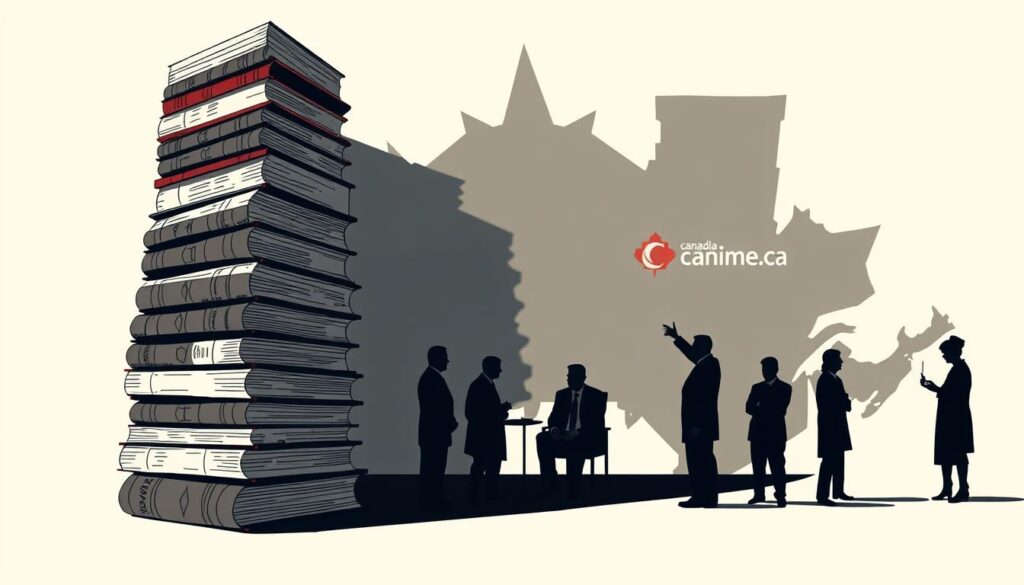
Section 163.1 has been amended several times since its creation. Key changes have strengthened and expanded the original provisions.
- The 2002 addition of “accessing” as a distinct offense, addressing online viewing without downloading
- The 2005 expansion of definitions and increased penalties
- The 2012 implementation of mandatory minimum sentences
- The 2015 refinements to definitions and penalty structures
The law now covers making, distributing, possessing, and accessing child pornography. It clearly defines child pornography, including visual, written, and audio materials.
Recent Legislative Updates
Canada continues to refine its legal approach. Recent changes address new challenges in the digital world.
Bill C-22 and Related Legislation
The Mandatory Reporting Act is a major advancement. It requires internet service providers to report child pornography on their platforms.
ISPs must report to designated organizations when they discover child pornography. They must preserve related data for 21 days. They can’t disclose information that could harm investigations.
Non-compliance carries serious penalties. Fines can reach $100,000 for corporations. Individuals may face imprisonment. This law increases private sector responsibility for child protection.
Pending Legal Changes
Canada’s legal framework continues to evolve. Pending changes aim to strengthen child protection measures. They focus on improving investigative tools and victim protection.
Proposed amendments address encryption, international jurisdiction, and new digital platforms. These changes show Canada’s commitment to fighting child pornography in the digital age.
Child Pornography Legal Guidelines in Canada
Canada’s legal system addresses child pornography cases through federal and provincial approaches. This multi-tiered system ensures consistent law application while allowing flexibility. It helps tackle the evolving nature of these serious crimes.
Federal Prosecution Guidelines
The Public Prosecution Service of Canada (PPSC) manages federal child pornography cases. It handles international cases or those within federal jurisdictions. The PPSC has set up comprehensive prosecution guidelines for these sensitive cases.
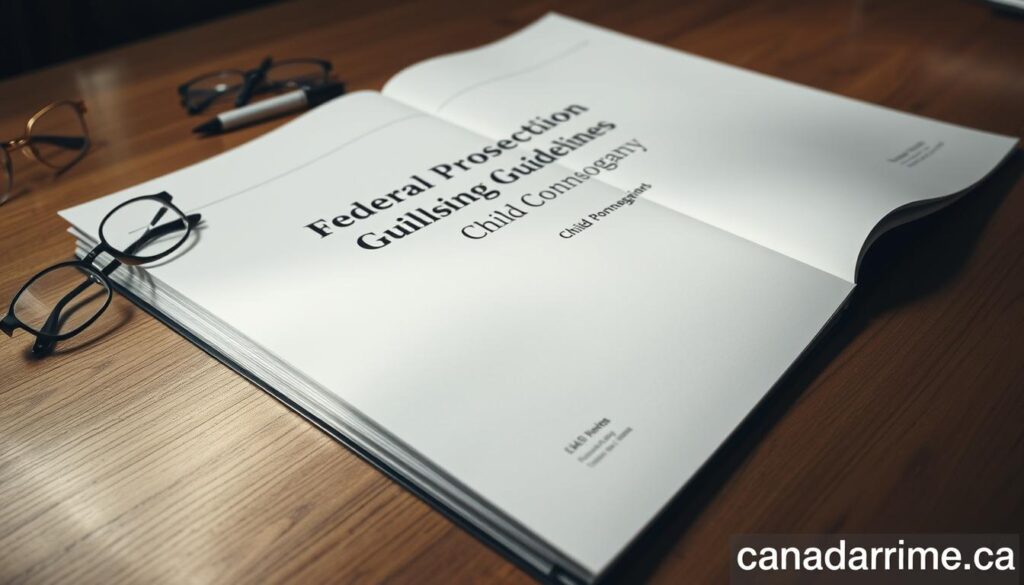
PPSC directives guide Crown prosecutors on various aspects of child pornography cases. These include case assessment, charging decisions, and sentencing recommendations. For serious offenses, prosecutors usually proceed by indictment rather than summary conviction.
One prosecutor noted,
“The PPSC guidelines emphasize the gravity of these offenses and provide us with the tools to pursue justice while protecting the dignity of victims.”
The directives also address digital evidence challenges. They cover preservation techniques, authentication requirements, and effective courtroom presentation methods. Prosecutors get guidance on seeking appropriate post-conviction conditions.
Jurisdictional Considerations
Child pornography cases often cross jurisdictional boundaries. This requires coordination between federal and provincial authorities. PPSC guidelines outline when federal prosecutors should lead cases.
- International elements or cross-border distribution
- Offenses occurring on federal property
- Cases involving organized crime networks
- Matters requiring specialized federal resources
Provincial Enforcement Approaches
Each province has developed specialized approaches to enforcing child pornography laws. These strategies complement federal efforts. They often focus on local investigation and enforcement.
Regional Task Forces
Provinces have established dedicated regional task forces to combat child pornography. These specialized investigation teams bring together expertise, resources, and technology. They focus specifically on these complex offenses.
- Ontario: Provincial Strategy to Protect Children from Sexual Abuse and Exploitation on the Internet
- Quebec: Sûreté du Québec’s Sexual Exploitation of Children on the Internet Unit
- British Columbia: Integrated Child Exploitation Unit
These task forces employ investigators with advanced training in digital forensics. They use sophisticated tools to detect online sharing of illegal material. They can trace digital footprints and recover evidence from encrypted files.
Provincial Reporting Systems
Each province has reporting systems that work alongside national reporting mechanisms. These systems facilitate quick responses to local reports. They coordinate with regional police units.
Provincial reporting frameworks include direct channels to specialized units. They coordinate with child protection services and educational institutions. These systems ensure reports are quickly assessed and directed to appropriate investigative teams.
The provincial approach allows for sharing of intelligence and best practices. It avoids duplication of efforts. These units also develop relationships with international partners and child protection organizations.
Reporting Procedures
Canada has specific protocols for reporting suspected child pornography. These protect victims and enable quick law enforcement action. The government offers multiple channels for reporting illegal content while maintaining confidentiality.
How to Report Suspected Child Pornography
Quick reporting of suspected child pornography is crucial. Canada provides several options to help authorities investigate and remove harmful content swiftly.
Online Reporting Mechanisms
Cybertip.ca is Canada’s national tipline for reporting online child sexual exploitation. This secure platform allows anonymous reporting. You’ll need to provide basic information about the content and where you found it.
Trained analysts assess reports and prioritize urgent cases. They forward actionable information to appropriate law enforcement agencies. These systems use encryption to protect reporter privacy.
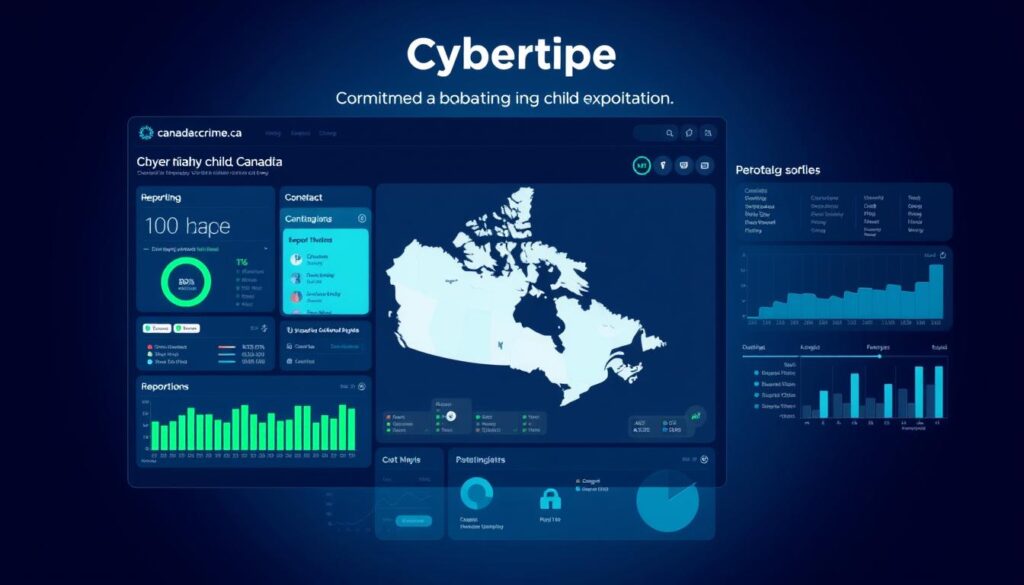
You can also report to local police or the RCMP. Most provincial police forces have online reporting portals. When reporting, provide detailed information about the content.
- Where you encountered the material
- When you discovered it
- Any identifying information about individuals involved
- Screenshots or URLs (if reporting online content)
Mandatory Reporting Requirements
Canadian law sets clear obligations for certain individuals and organizations regarding child pornography reporting.
Obligations for Service Providers
The Mandatory Reporting of Internet Child Pornography by Persons who Provide an Internet Service Act requires ISPs to report child pornography. They must report discoveries on their systems to authorities.
- Reporting to authorities when discovering child pornography on their networks
- Notifying officials about websites containing such content
- Preserving related computer data for 21 days to facilitate investigation
- Destroying preserved data after 21 days unless required by judicial order
Non-compliance can result in fines up to $100,000 for corporations. Individuals may face potential imprisonment for failing to report.
Professional Reporting Duties
Some professionals have increased reporting responsibilities under mandatory reporting laws. These include teachers, healthcare providers, social workers, and childcare professionals.
They must report suspected child abuse, including pornography production or distribution. Reporting duties vary by province but generally require immediate notification to proper authorities.
Legal Consequences and Penalties
Child pornography offenses in Canada have severe legal consequences. The Canadian legal system has strict measures to combat these crimes. These penalties affect many aspects of an offender’s life for years.
Criminal Sentences
The Criminal Code of Canada outlines sentencing for child pornography offenses. Courts apply appropriate penalties while considering each case’s unique circumstances. These sentences reflect the significant harm these crimes cause to children and society.
Minimum and Maximum Penalties
Canada has mandatory minimum sentences for all child pornography offenses. These minimums vary based on the specific offense and prosecution method. The severity depends on whether it’s an indictable offense or summary conviction.
| Offense Type | Prosecution Method | Mandatory Minimum | Maximum Penalty | Criminal Code Section |
|---|---|---|---|---|
| Making Child Pornography | Indictable | 1 year | 14 years | 163.1(2) |
| Distribution | Indictable | 1 year | 14 years | 163.1(3) |
| Possession | Indictable | 1 year | 10 years | 163.1(4) |
| Possession | Summary | 6 months | 2 years less a day | 163.1(4) |
| Accessing | Indictable | 1 year | 10 years | 163.1(4.1) |
Aggravating Factors
Courts consider aggravating factors that may increase penalties. These factors reflect circumstances that make the offense particularly harmful. They also indicate a higher risk to society.
Key aggravating factors include:
- The age and vulnerability of the children depicted
- The relationship between the offender and the victims
- The quantity of material possessed or distributed
- The duration of the criminal behavior
- Whether the offense was committed for commercial purposes
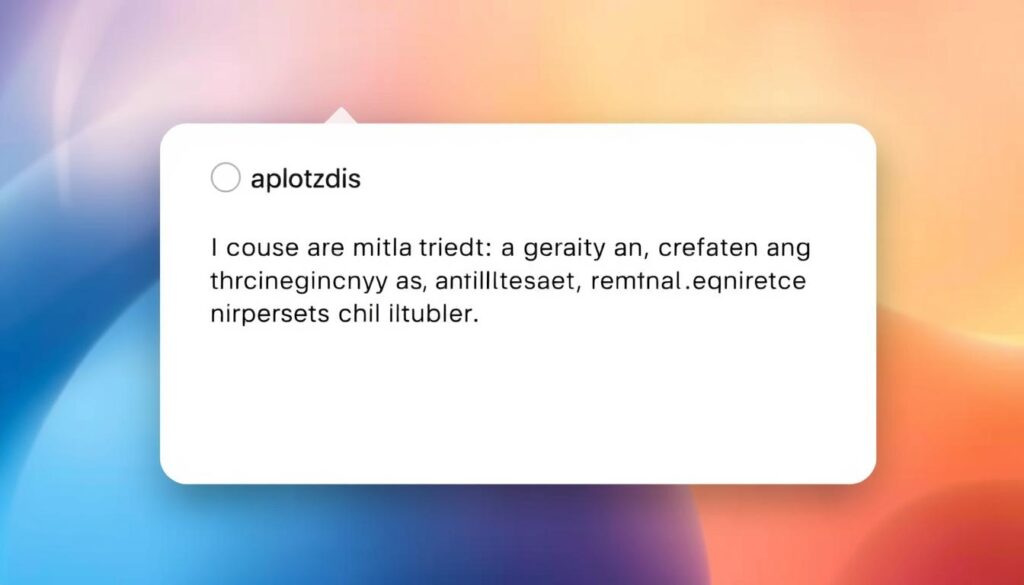
Sex Offender Registry
Child pornography convictions trigger mandatory sex offender registration. This falls under the Sex Offender Information Registration Act (SOIRA). The registry helps law enforcement monitor offenders after their release.
Registration Requirements
The SOIRA requirements are comprehensive and strictly enforced. Offenders must register within seven days of conviction or release from custody. The registration process requires detailed personal information.
You must provide:
- Your full name and any aliases
- Date of birth and current address
- Telephone numbers and email addresses
- Employment information
- Physical description
- Photograph
Duration of Registration
Registration length depends on the offense’s severity. It ranges from 10 years to lifetime registration. Failure to comply is a separate criminal offense with up to two years imprisonment.
Long-term Impact of Convictions
Child pornography convictions have lasting effects beyond the sentence. They impact many aspects of your life permanently. These convictions create significant barriers to employment and travel.
Employment Restrictions
These convictions appear on your permanent criminal record. They show up in background checks and vulnerable sector checks. You’ll face barriers in education, healthcare, elder care, and youth recreation.
Professional licensing bodies often disqualify individuals with these convictions. This affects careers in law, medicine, nursing, and social work. Existing credentials may be revoked.
Travel Limitations
Many countries deny entry to individuals with child pornography convictions. The U.S. considers these offenses as crimes of “moral turpitude”. This can result in permanent inadmissibility.
Canada can revoke or deny passports to high-risk child sex offenders. This further limits international travel options. You may face enhanced screening and potential entry denial at borders.
Prevention Measures and Initiatives
Canada fights child pornography through education and new tech. The government, police, and charities work together to protect kids. They use both teaching and tech solutions to tackle the issue.
Educational Programs for Parents and Children
Canada has created child protection education programs for kids and adults. These teach how to spot and prevent exploitation. They’re the first defense against child pornography.
School-Based Prevention
Canadian schools use safety programs to protect kids from sexual exploitation. These are part of school lessons and fit each age group. The Canadian Centre for Child Protection runs “Kids in the Know”.
It teaches personal safety and healthy relationships. Young kids learn about private parts and safe touch. Older students learn about online safety and digital citizenship.

Teachers get special training to teach these topics. They learn how to handle sensitive info from students. Many schools team up with police for expert talks.
Online Safety Education
Special programs teach internet safety to parents and kids. They focus on empowerment, not fear. Kids learn to spot problems and get help online.
Parents learn about monitoring tools and setting internet rules. They’re taught to keep talking with kids about online activities. This helps kids feel safe reporting online issues.
Law Enforcement and Industry Initiatives
Canada uses new tech to fight child pornography. These tools find and remove harmful content. They also help identify victims and offenders.
Project Arachnid and Similar Programs
Canada created Project Arachnid to find child abuse images online. It’s a web crawling technology that searches the internet. When it finds illegal stuff, it tells the website to remove it.
Project Arachnid has checked millions of images and sent many removal notices. The RCMP also uses a system to track child exploitation across Canada.
Internet Service Provider Cooperation
Canadian content removal systems work with internet providers. Many providers block known child exploitation material. Police share info to catch offenders across borders.
Canada keeps improving its fight against child pornography. These efforts help protect kids from exploitation.
Resources and Support Services
Canada offers specialized resources for child pornography cases. These address unique challenges faced by victims, families, and legal professionals. Support services and training programs are available nationwide.
For Victims and Families
Specialized support services exist for those affected by child pornography. These services recognize the unique trauma of this exploitation. They offer tailored assistance across Canada.
Counseling and Therapy Services
Provincial victim services provide trauma-informed therapy for child pornography victims. Centers like Boost in Ontario and Zebra in Alberta offer comprehensive support.
These services use Trauma-Focused Cognitive Behavioral Therapy adapted for exploitation cases. The therapy addresses the complex impacts of recorded abuse.
Family members can access support for secondary trauma. Many programs offer extended services throughout victims’ development.
Victim Compensation Programs
Provincial victim support programs offer financial aid for therapy and medical expenses. These programs recognize the need for long-term support. This is crucial when images continue circulating online.

For Legal Professionals and Organizations
Canada has developed training resources for legal professionals handling child pornography cases. These resources provide specialized knowledge and skills for sensitive matters.
Training Resources
The National Judicial Institute offers judicial education on digital evidence and psychological impacts. The Public Prosecution Service provides specialized prosecutor training on managing evidence.
Law enforcement can access courses through the Canadian Police College. These focus on digital evidence collection and victim-centered investigation techniques.
Legal Aid and Advocacy Groups
Bar associations provide legal professional training on representing clients in child pornography cases. These resources emphasize technical competence and trauma-informed approaches.
The Department of Justice has developed best practices for legal proceedings. These guidelines help minimize additional trauma while pursuing accountability.
Canadian Law vs. International Approaches
Child pornography is a global issue that requires strong international teamwork. Canada has solid laws to fight these crimes. However, success depends on how well Canadian authorities work with foreign partners.
Understanding these global aspects is key for legal experts and concerned citizens. It provides vital context for tackling this serious problem effectively.
Cross-Border Enforcement Challenges
Child pornography cases often involve multiple countries, making them hard to solve. Offenders may operate from abroad. Evidence might be on foreign servers.
Canadian authorities face complex jurisdictional challenges when trying to catch criminals. They must work across borders to bring wrongdoers to justice.
Extradition Issues
International extradition is crucial when suspects are outside Canada. Canada has treaties with many countries to transfer accused persons.
However, this process has major hurdles. The crime must be illegal in both countries. Legal proceedings can be long.
Some nations won’t extradite their citizens. Keeping digital evidence safe during long cases is challenging.
International Cooperation Mechanisms
Canada has developed tools for cross-border prosecution. INTERPOL’s database helps compare images and identify victims globally.
Treaties allow countries to share evidence. Joint investigation teams enable coordinated operations across borders.
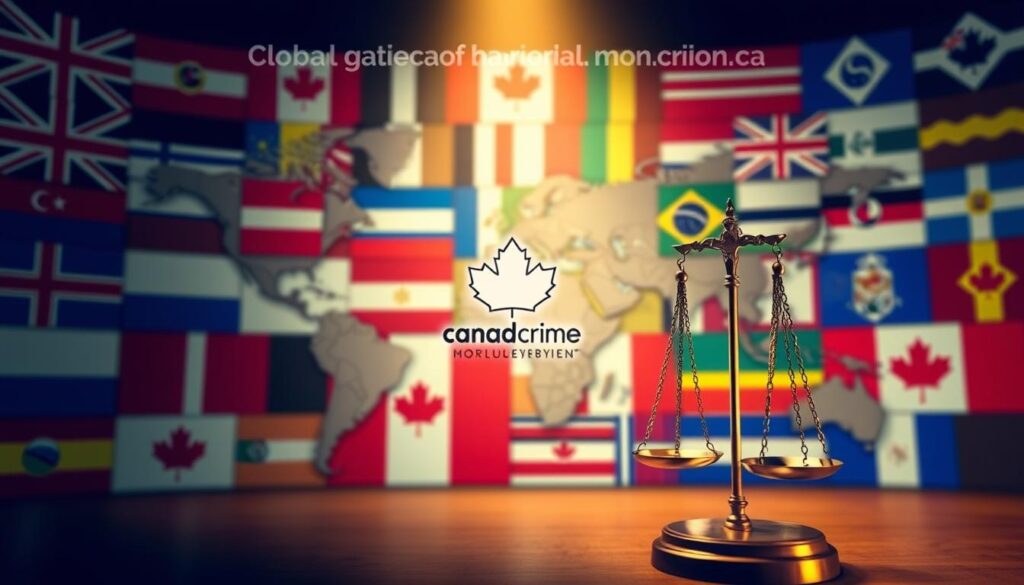
Comparative Legal Frameworks
Canada’s child pornography laws fit into a range of foreign enforcement models. Looking at these differences can help improve Canadian laws.
US and European Approaches
The US and Canada both set 18 as the age limit for child pornography. But US federal law has much harsher minimum sentences.
European laws often have different penalties based on the child’s age. They also consider the age gap between the child and offender.
International Treaties and Obligations
Several global agreements set global legal standards for fighting child pornography. The Optional Protocol creates basic rules for countries that sign it.
The Budapest Convention helps countries work together on digital investigations. INTERPOL and Europol help police agencies worldwide coordinate their efforts.
Conclusion
Canada’s laws against child pornography act as a crucial shield for children. Section 163.1 of the Criminal Code provides clear definitions and serious penalties for various offenses. These laws form a comprehensive structure to protect minors.
Your knowledge of these laws helps protect children. The guidelines cover making, distributing, possessing, and accessing such material. Each offense carries significant consequences, including jail time and sex offender registration.
Reporting suspected child pornography is vital. Use Cybertip.ca or contact local law enforcement immediately if you encounter such material. Canadian internet providers must report these crimes, creating a vigilant network.
Your understanding of these laws supports child protection efforts across Canada. Coordination between law enforcement, prosecutors, service providers, and the public strengthens these protections.
Challenges exist in cross-border enforcement and keeping up with technology. However, Canada remains committed to protecting children from exploitation. By staying informed, you join the effort to safeguard children and support enforcement mechanisms.

